(800) 748-5647
(800) 748-5647
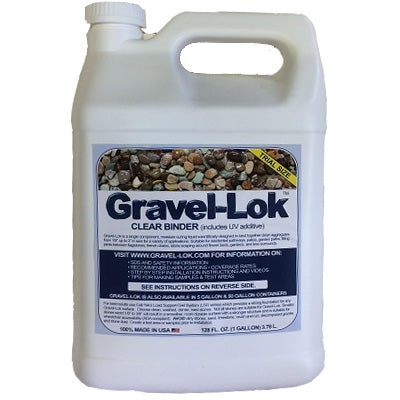
Designed to keep gravel in place, Gravel-Lok binds various types of gravel together providing a strong-porous surface which can be installed in a w...
View full details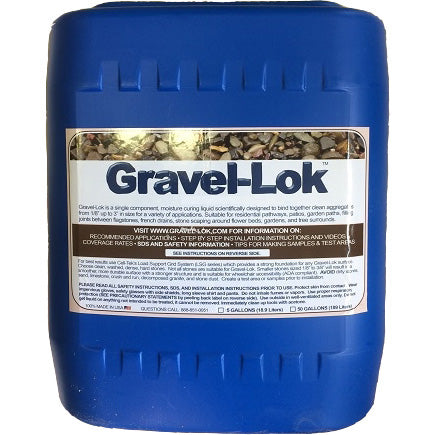
Designed to keep gravel in place, Gravel-Lok binds various types of gravel together providing a strong-porous surface which can be installed in a w...
View full details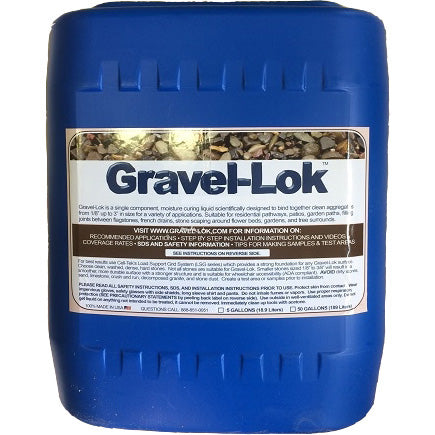
Designed to keep gravel in place, Gravel-Lok binds various types of gravel together providing a strong-porous surface which can be installed in a w...
View full details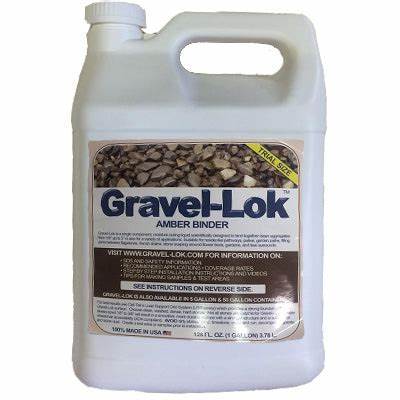
Designed to keep gravel in place, Gravel-Lok binds various types of gravel together providing a strong-porous surface which can be installed in a w...
View full details
Designed to keep gravel in place, Gravel-Lok binds various types of gravel together providing a strong-porous surface which can be installed in a w...
View full details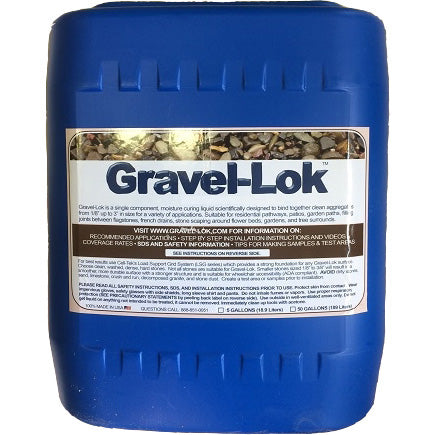
Designed to keep gravel in place, Gravel-Lok binds various types of gravel together providing a strong-porous surface which can be installed in a w...
View full detailsGravel-Lok, also known as "Gravel Glue" is a Polyurethane-based which acts as a stone binder when applied to gravel. The end result is a firm walking surface which is also permeable, allowing water to pass through.
 Gravel Lok Resin Bonded Surfaces
Gravel Lok Resin Bonded SurfacesGravel-Lok™ single element, moisture curing liquid adhesive that was designed to bond a variety of aggregates. When this adhesive is used with Cell-Tek's LSG Series™ Load Support Grid, it will create an absorbent, durable natural stone surface that can be used in many different civil, residential and industrial applications. It is also ideal for municipalities, parks, other porous surface projects, and stonescaping in residential areas.
Combining natural pebbles with a polyurethane binder and then apply with a trowel to create the surface you are looking for that is decorative and attractive.
This gravel locking product is available in two different formulas, clear and amber. Each is available in a one-gallon trial size, 5-gallon container, or a 50-gallon drum.
The Clear Formula:
Comes colorless or light yellow in color that is ideal for white or other stone colors. It's a great choice for residential walkways, patios, garden paths, stonescaping, french drains, along flower beds in gardens, tree pits, and surroundings.
The Amber Formula:
If you want your white stones to remain white, do not use this formula, they will change color. It great for residential garden pathways, stonescaping around your flower beds in the garden, french drains, and tree surroundings.
The Benefits:
• Very easy to install
• Very strong
• Comes with artistic design options
• Multiple styles, colors, and textures
• ADA compliant when used with 1/8-inch to 1/2-inch size stones
• Made in the USA
Benefits For The Environment:
• Captures airborne pollutants
• Reduces stormwater runoff
• Reduces hot temperatures on the surface
• Naturally recharges groundwater
 Decorative Surface Options:
Decorative Surface Options:
• Pea and River Gravel
• Granite
• Marble
• Recycled Glass & Many More!
The following is general information pertaining to resin boding. (Gravel-Lok is a resin bonding product) For instructions on this product specifically refer to the official installation instructions, not the below information which is general in nature.
How Resin Bonding Is Done:
Scatter loose dried aggregate on a coating of resin directly after the resin is applied to the surface. This process is commonly referred to as broadcast coating, scatter coating or coating systems.
Another method is applying the resin over an appropriate base using a squeegee then scatter the aggregate over it before the resin sets.
What Kind Of Base Should Be Used?
Resin-bonded systems can be used on existing or new bases. Usually, the surfaces are tarmac, concrete, asphalt, or other singular stone material as long as it has been cleaned including the removal of loose materials and dust and then properly prepared. If needed use a sealant if necessary to ensure the resin will adhere to the base. Any remaining contaminants such as oil, film algae or fungus will have to be removed with a good degreaser.
Ensure the base is in good condition because the finish and life-expectancy depend on the durability of the base.
Make sure your base is level, any damaged sections or cracks are properly repaired before applying the resin. Always ensure the base is suitable for the traffic load that will be expected to carry once the resin system is applied. The suitability of a base can vary depending on the system being used. It is recommended that you get advice from the resin supplier beforehand.
Surfaces with fewer joints that are usually larger provide the best finishes. This includes tarmac or concrete. Bases that are made of paving products such as block paving are Not Recommended For Use. This is due to the cracks and lines below the surface that will ultimately cause cracks in the resin and eventually will fail due to extreme pressure placed on the resin day after day.
When laying a new base for the resin, make sure it has been allowed to cure properly before applying the resin. Bitumen is a black mixture of natural hydrocarbons or residue from petroleum distillation that is commonly used on roads. These surfaces should be allowed to cure for 28 days in order to allow it to oxidize and weather.
Concrete will need at least 7 days to cure correctly. It is also important to understand that any base used, the moisture levels on the surface must meet the acceptable level recommended by the resin manufacturer. All the advice of the manufacturer and their recommendations should be followed. This includes preparation, proper cleaning, etching, or any other process that is being used.
For all surfaces that are absorbent, a primer should be applied which includes concrete surfaces. This usually consists of a 2-pack fast curing epoxy primer along with a scattering of C52 sand, which will set in approximately 90 minutes. Be sure to mask off any areas or corners that are nearby but be sure to remove them before the resin fully sets.
 Other Types Of Bases:
Other Types Of Bases:
Some manufacturers claim that wood decking, paving flags, and block paving can be used. The general opinion within the trade strongly suggests not to use the basis. Even though outdoor decking could be coated, wood is very unstable and will lead to cracking taking place in the resin. If the wood base is going to be used, only choose an exterior grade of wooden deck surface.
Can The Application Process Take Place In Any Weather?
Changes in temperature and humidity can have an effect on the application process and the time it would take to cure. If there is a prediction of rain or it's very damp, then the application should not be done. If there is a chance of rain within 24-hours of the application it is advisable to cover up the resin to protect it and prevent water from reacting with the uncured resin. Again, it's always advisable to follow the guidelines set by the manufacturer and what suitable conditions should be.
Different Kinds Of Resin And How To Mix It:
There are two leading kinds of resin for bonding, Aromatic Resin and Aliphatic Resin and both have different properties and use.
Aromatic Resin:
This is a Non UV Stable polyurethane resin used in both resin bound and bonded applications. It will be affected by sunlight by changing the color to a darker shade and is typically used for darker aggregates or for non-decorative applications. It is also less expensive than the Aliphatic UV Stable Resin.
Aliphatic Resin:
This is a Clear UV Stable polyurethane resin that is great for all applications and is not affected by sunlight. Which means it will not change color allowing aggregates to retain their best appearance. This resin will not fade but it is more expensive.
How To Mix Resins:
Both the resin and hardener should be mixed using a drill paddle mixer for approximately 23 minutes to ensure everything is properly blended. An accelerator should also be added at this time if colder temperatures below 15 degrees apply or if there will be a light rain or dew overnight. An accelerator is needed to fast cure the resin if temperatures will be dropping below the recommended level by the supplier. In warm temperatures, the setting time can be between 2 to 4 hours but in the fall and winter months, the resin can still be somewhat tacky the next morning which is why an accelerator is recommended. The accelerator will prevent resin from being affected overnight when temperatures drop and moisture increases.
 How Resin Is Laid:
How Resin Is Laid:
After thoroughly mixing, mask off edges that need to be protected and before pouring the resin. The resin is then poured in a series of lines and then spread evenly over the prepared surface using a serrated squeegee.
Leave it alone for approximately 10 minutes to allow the resin to level out or self-level. Then broadcast the aggregate or mop the surfaces. Broadcasting should ensure that the resin is completely covered. Make sure you do not walk on the aggregate or resin while performing broadcasting. Once the process has been performed, masking tape should be removed. As the aggregate settles on the surface, keep an eye out for any heavy areas of excess resin and ensure that sufficient aggregate has been applied to keep consistency in appearance. If another area needs to be covered, leave a wet edge and start the process again while the other area is set, continue this process until it's completed.
How Much Aggregate Should Be Used?
With a resin bonded application, typically it would take between 8 to 10kg per square meter.
The Available Colors:
There are over 50 different aggregates available and therefore just about any color scheme can be catered for. Carefully blending with different colors can create a different look and color. Also, there are a number of aggregates can be colored to let customers select finishes of just about any color they want.
__
Aggregate bonded systems will provide a long lasting, nice finish that requires practically no maintenance if applied properly. How the bond between the resin and base is applied is critical for success.
It is highly recommended you hire an experienced, reputable contractor to prevent most issues associated with the finish. If the surface has not been seal properly and the base it was applied to was not a suitable material or frost and moisture were present, the top surface could separate from the base.
Any insufficient work performed on this kind of surface, such as concrete or tarmac, will show signs that would require patch cutting of the surface then be resurfaced. The aging of the original product and the variations in color of the stone would be almost impossible to blend in.
Note:
It is critical that the aggregates are dust-free, clean, and consistent or they will not bond!
Cleaning The Surface:
One upside to resin-based surfaces, they are very low maintenance. Always follow the instructions provided by the resin manufacturer before cleaning. In most cases, a gentle power wash is all that will be needed to clean the surface.
PLEASE NOTE:
The preceding is general information only. Any technical information, application instructions, which include H&S information, safety data sheets, method statements, and COSHH information, should be supplied by the supplier of the system. Paramount Materials accepts absolutely no responsibility for any applications taken using the information provided on this site.
For more information on resin bonding installations please see the official blog
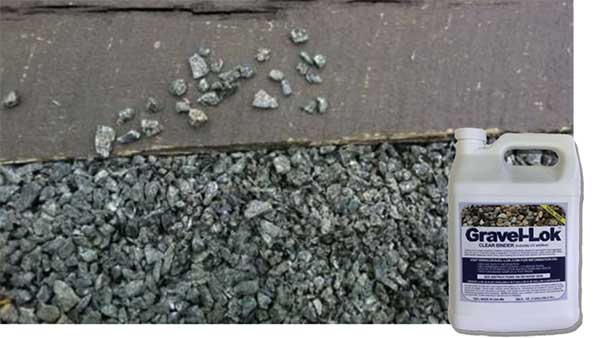
Pour on gravel binder is a technique that uses resin to bind loose stones and gravel; once applied, the surface becomes hard, smooth, and easy to walk on.
If you're seeking to improve the quality and appearance of your hardscape, a gravel binder is a great place to start. In the rest of this article, I'll give you a crash course for pour on gravel binders.
If you’ve ever slipped on loose gravel, you may have wondered about ways to make the terrain less treacherous. You may have then wondered about the safety of your loved ones. Will one of them be the next to fall? Here is where gravel binder can play a huge role.
Gravel binder is a resin solution that bonds loose stone and pea gravel into a solid surface; it is applied in a sprinkle, or "pour on" form over a wide area, then left to dry. It is commonly used for Patios, Walkways, Residential Driveways, and for decorative garden areas.
The binder flows a bit like the syrup over the surface, bonding the surface of the gravel to create a more uniform look. Your pour-on gravel binder will unify the surface into a safe, consistent shell of its own.
Basic instructions for application are as follows:
● Clean the application area of all debris and excess dust.
● Sprinkle your pour on gravel binder onto the surface of stones or gravel using a watering pail.
● Cover the aggregate evenly but do not use too much binder (or too little). View Gravel-Lok coverage guide >
● Using a trowel, smooth over bumps or rough edges.
● Allow the binder to dry overnight, then apply a second coat to achieve a more robust bond.
● Allow the second coat to dry overnight.
Most gravel binders are made of water-based polyurethane which acts as a resin. This helps them bond strongly to almost any surface (including stone). It also creates a tough, durable coating that will last for years.
Pour on gravel binder normally comes in two different shades. Depending on the color of the surface you have, you’ll want to choose accordingly.
● Use a clear gravel binder if you want UV protection for your aggregate (the color of the binder will not fade to yellow over time).
● Use amber gravel binder to achieve a darker, more gilded-like appearance (and save a bit of money).
Clear will cost you a few extra dollars, but many clients are more than okay with this, considering the original color of the stones is retained. Clear binder will also protect the surface from ultraviolet rays, whereas amber will not.

As an effective binder, both clear and amber do quite well. Just keep in mind that the amber option will leave your aggregate more susceptible to UV yellowing.
Pour on gravel binder is a terrific method for transforming loose stones into a hard, heterogeneous surface you can walk on with total confidence. It is also safe for wheelchairs and bicycles. Having said as much, I must not fail to address a caveat or two.
With proper application, your gravel binder creates a stable, attractive surface that can last for over 5 years. It is not only practical but cosmetically enhancing as well. In fact, the look of your entire landscape will be enhanced. Some other limitations to keep in mind include:
● Pour on Gravel Binder like Gravel-Lok will need to be reapplied periodically as stones get dislodged over time.
● The surface gloss of the resin will fade after about half a year. However, at points just below the surface, the shine will remain.
● Excess saturation may prevent the resin from drying properly. Use an applicator such as a watering can for controlled flow.
When planning, measuring the proper amount of binder for your coverage area is key.

It is recommended to first test the binder-to-stone ratio by applying 20 ounces (567 grams) of binder to five gallons (22.73 liters) of stone spread over a test area. Cardboard makes a good choice for this, but any surface that clearly shows when it’s wet will do. Pour the binder onto the stone and wait 15 minutes.
If after that time, the test area beneath the stones is wet, then the stones are absorbing at just the right amount. If the test area is still dry, add 2 more ounces (56.7 grams) of binder and try again. Continue to add 2 ounces (56.7 grams) for each test until the test area shows moisture.
With the proper mixture at a 2” depth of gravel stones, you can treat about 18 square feet of stone per gallon of the binder.
Depending on the depth of stone of your project, the exact measurements may vary.
Anything permeable allows water or gas to pass through it. Most cloth is permeable (you know this if you’ve ever been sprayed with a garden hose), and so is hardwood flooring. Even some forms of rock are permeable. Your pour on binder need not cancel this property.
A permeable binder keeps stones and gravel sealed while allowing liquids to pass through. This prevents water from flooding the surface and making you wish you'd just left those stones alone.
After all, it won't do in the slightest to see the garden walk-path shimmer under 4 inches of water after a hard rain, or to play driveway basketball in galoshes. If you're concerned about flooding, do be certain to use a permeable pour on binder.
Most pour on gravel binders contain polyurethane. Polyurethane is most loosely defined as synthetic resin. Indeed, it is often referred to as a resin blend.
The compound is quite versatile. With the addition or subtraction of additives, it can be molded into different shapes or even applied in liquid form to a field of loose stones. Pretty much anywhere you use plastic, you could be using polyurethane. Some examples include:
● Insulation
● Dishware sponges
● Automobile parts
● Sealants and adhesives
So is polyurethane the same as plastic? Not quite. The former is more flexible under duress. It's also more resistant to impact and has a good memory (it will return to its original shape when twisted out of true).
So far, we’ve covered the uses of aggregate binders around the home. This is likely all the info most readers will need. Yet for those of you willing to delve a little further—and perhaps become even more reassured by the product in question—allow me to touch briefly upon the industrial benefits of pour on gravel binder.

The organization of loose aggregate is a concern for places such as:
● Highway median strips
● Railroad embankments
● Parking lots
These are just to name a few. Over a period of decades, bitumen (asphalt) has become a popular method of constraining loose rubble. Contractors almost swear by it; but is there another way?
In 2018 a group of scientists became curious as to whether or not a polyurethane binder over gravel could act as a substitute for asphalt. Their findings were in the affirmative. As it turned out, the poly binder worked just as well to constrain gravel as asphalt. This proved that pour on binders could indeed be effective enough for use on slopes, roads, and other places that endure hard use.
The operative word in that last sentence is could. Please do not forget that not all binders are created equal. If you’ve already decided to use pour on binder for your hardscape, do check the container for limitations. Do this before laying money down for purchase.
Pour on gravel binder is typically sold in either 1 gallon or 5-gallon containers. Around the home, it is a marvelous product for turning loose gravel into a clean, hard surface that’s easy to walk on.
Think of how sugar and corn syrup make peanut brittle. Pour on gravel uses the same idea, only with different ingredients and less edible results. It is safe, water permeable, and with some TLC, you'll get years of reliable service.
Sources
● Gravel-Lok Coverage Rates
● Ebsco Information Services: Physical And Mechanical Properties Of Polyurethane Crushed Stone For Slopes Of Embankments And Excavations Of Roads And Railways
